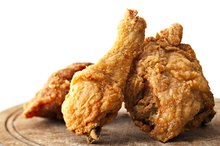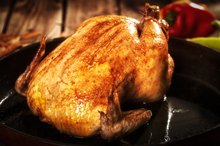Nutrition Information For Chicken Wings
You probably enjoy ordering a large serving of chicken wings and devouring them while you watch movies, chat with the girls or catch the game. What you might not realize is how the calories are adding up like numbers on a scoreboard. To stick to a healthy eating plan and still enjoy your favorite dish of wings, consider the preparation method, whether or not to eat the skin, the sauce and the side dishes.
Calories and Fat
One chicken wing fried in batter contains 160 calories, 16 percent daily value, or DV, of fat, 14 percent DV saturated fat and 12 percent DV cholesterol. These are high numbers considering no one will eat just one wing. According to FDA guidelines, 100 is a moderate amount of calories and 400 is a high level of calories in a food. One chicken wing falls between those numbers, although a whole order of wings will go over the high range. The FDA considers less than 5 percent low and over 20 percent high in terms of nutrients you want to keep low, like fat and cholesterol. One chicken wing is at a moderate level on this scale and a whole order will tip it over.
- One chicken wing fried in batter contains 160 calories, 16 percent daily value, or DV, of fat, 14 percent DV saturated fat and 12 percent DV cholesterol.
- One chicken wing falls between those numbers, although a whole order of wings will go over the high range.
Sauces and Side Dishes
How to Eat Healthy at White Castle
Learn More
Add the sauces and sides that typically go along with chicken wings. The barbecue sauce your wing is drenched with contains 60 calories and 10 percent daily value of sodium per 2 tablespoons. That amount would probably only cover one wing. If you like to dip your wings in blue cheese dressing, 1 tablespoon has 80 calories, 15 percent DV fat and 10 percent DV saturated fat. A large serving of french fries on the side adds 200 calories, 48 percent DV fat and 32 percent DV saturated fat to your meal.
- Add the sauces and sides that typically go along with chicken wings.
- The barbecue sauce your wing is drenched with contains 60 calories and 10 percent daily value of sodium per 2 tablespoons.
Nutrients
On a positive note, chicken wings contain some nutrients that you want to add into your diet. One wing has 20 percent daily value of protein. In terms of micronutrients, a wing contains 13 percent DV niacin, 7 percent DV vitamin B6, 6 percent DV phosphorus and small amounts of a number of other vitamins and minerals. The FDA considers less than 5 percent low and over 20 percent high when calculating nutrients you want at a high level in your diet, such as vitamins and minerals.
- On a positive note, chicken wings contain some nutrients that you want to add into your diet.
- The FDA considers less than 5 percent low and over 20 percent high when calculating nutrients you want at a high level in your diet, such as vitamins and minerals.
Solution
Dijon Mustard Nutrition
Learn More
The method of preparing chicken wings invariably makes a difference in the nutrition of the meal. Many restaurants offer grilled wings as an alternative to fried or you can grill them at home. One grilled chicken wing contains 65 calories, which is much less than the battered and fried counterpart. It has 8 percent fat, 5 percent saturated fat and 2 percent cholesterol, making this a healthier choice. Consider taking the skin off your wings before eating them. A roasted chicken wing with no skin has only 43 calories, 3 percent fat and 2 percent saturated fat. Skip the dips, or use them in moderation and choose healthier side dishes like a salad or coleslaw instead of those french fries.
- The method of preparing chicken wings invariably makes a difference in the nutrition of the meal.
- One grilled chicken wing contains 65 calories, which is much less than the battered and fried counterpart.
Related Articles
References
- U.S. Food and Drug Administration: How to Understand and Use the Nutrition Facts Label
- Livestrong.com: My Plate
- Wingstop. Menu. Updated September 21, 2020.
Writer Bio
Sharon Therien has been writing professionally since 2007. She specializes in health writing and copywriting for websites, blogs and businesses. She is a Certified Yoga Teacher and a Reiki Master with a Certificate in Fitness and Nutrition. Therien has a Master of Arts in sociology from Florida Atlantic University.








